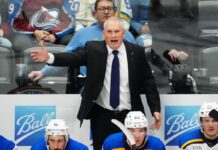We’ve now got a ratified CBA extension, Return to Play protocols, and tentative playoff series schedules.
As of Friday, Toronto’s selection as the Eastern hub city has also been officially confirmed. There is no real home-ice advantage in a bubble without fans, but it’s a definite plus that the Leafs don’t have to travel south of the border for training camps or the competition phase, and they can remain in the comforts of home before transitioning into the bubble downtown Toronto at the end of the month. I do think the buzz within the city during a Leafs playoff run will be felt by the team, even if it’s a lot more indirect than the typical postseason, and the familiarity with the rink and the facilities is a bonus.
That said, it’s white-knuckle time for the league starting on Monday as to the viability of proceeding with Stage 4 as planned. Positive test outbreaks within multiple camps — and we’re all paying particular attention to Florida, Arizona, Texas, Nevada, and North Carolina here — means there is no chance of starting August 1. Of course, any delay of significance brings into question the timeline of a drop-dead date for finishing the playoff tournament while accounting for the offseason schedule and the imperative of a full 2020-21 regular season.
Enough of the break-pumping, though, as it’s an exciting weekend of news in the hockey world.
On the flat cap

The line I’m hearing just about everywhere: It’s just the Toronto Maple Leafs’ luck that this economic crisis — and the resulting flat cap — has hit just as the team is capped out and entering its Cup window. There is no doubt that life just got harder for Kyle Dubas, Brandon Pridham, and co., as it has for many front offices around the league. But we can’t take such a surface-level view on such a dynamic, complex, and unpredictable situation vis a vis the Leafs, the cap, and the league’s economic future.
For one, the cap is freezing (this we know for sure) and (hopefully) growing slowly from there — not falling, thankfully. And at a time of great economic turmoil, you would always rather be a rich, large-market team than not. Depending on a whole host of factors — most notably, when you think a vaccine could be widely available — we could be talking about a 2020-21 season partially or entirely without gate revenue in a league that is particularly reliant on it. While the players have agreed to defer 10% of their salaries in 2020-21 plus the escrow holdback (20%), league revenue could be significantly worse off than 70% of pre-pandemic projections and it may well be several years before league owners are whole again.
We could easily envision a scenario where the existence of cap-floor (or close to it) teams becomes more common, or at least, where internal payroll budgets across the league are significantly reduced. As a team that could feasibly remain a cap-ceiling team throughout an extended period of economic hardship, the Leafs will have hard decisions to make while still operating at a competitive advantage in the new economic reality.
Projecting the league’s financial situation far down the road right now with any degree of certainty would be foolhardy, but in the immediate term, we know the Leafs are entering an $81.5 million cap year in 2020-21 with (thankfully) just a pair of middle-of-the-road RFAs of note due up for raises — Ilya Mikheyev, Travis Dermott — as well as potentially quite a few ELCs ready to step into the team full time as soon as the start of next season, including Rasmus Sandin, Alexander Barabanov, Mikko Lehtonen, Timothy Liljegren, and Nick Robertson. Raises are kicking in for Jake Muzzin, Jack Campbell, and Pierre Engvall, while Cody Ceci and Tyson Barrie’s cap numbers are off the books after the playoffs.
With roughly $76 million committed to 16 players, it’s going to be tight to operate and a busy series of months is upcoming for management — but it’s not impossible to navigate, and the Leafs have the significant advantage of being financially flexible at a time when many clubs around the league may have no choice but to tighten their belts.
On the bottom six & playoff lineup

Lord knows there has been enough pandemic, CBA, and RTP talk. Let’s get into some hockey discussions.
One of my biggest question marks entering Leafs’ camp is how Sheldon Keefe sorts out his bottom six. To me, it contributed to some of the unevenness in the team’s performances; when the heavy-minute big guns weren’t at their best, like on the California road trip prior to the break and in some of the blowout losses they experienced, they weren’t getting much of a lift out of the depth lines. It could be partly, although not fully, explained by all of the injury situations, but opportunity for players in depth roles was also limited under Keefe.
The issue seems particularly critical entering the playoff qualifying round for a number of reasons. We are now entering a situation where the 24 playoff teams are going from four months off of competitive action into training camps, followed by one exhibition game, and then right into a hot-and-heavy playoff schedule. If the series versus Columbus goes four games, for instance, the two teams play four games in six days between August 2 and 7, as Games 3 and 4 will be played back-to-back. It will be a lot of intense competitive action inside a week, and a couple of weeks of camp beforehand is not going to have the players 100% prepared physically for this.
On top of all of that, Columbus’ four-line approach is a little more established as John Tortorella has rolled his lines more than the Leafs have all year, although it’ll be a different lineup picture with their team now fully healthy. Under Keefe, the Leafs were riding their big guns very heavily, to the point where it was questionable how it was all going to transfer into long, grueling series, let alone multiple playoff series if the team were to finally advance past the first round.
Here were the Leafs’ lines in their win vs. Tampa Bay on March 10th prior to the pause:
11 Zach Hyman – #34 Auston Matthews – #88 William Nylander
#24 Kasperi Kapanen – #91 John Tavares – #16 Mitch Marner
#47 Pierre Engvall – #15 Alex Kerfoot – #62 Denis Malgin
#73 Kyle Clifford – #33 Frederik Gauthier – #19 Jason Spezza
#23 Travis Dermott – #3 Justin Holl
#44 Morgan Rielly – #83 Cody Ceci
#38 Rasmus Sandin – #94 Tyson Barrie
Obviously, Jake Muzzin is good to go now, and the return of Ilya Mikheyev is noteworthy for the team’s overall depth up front. He was slotted in and playing well on John Tavares’ wing — in addition to providing good minutes on the penalty kill, a weakness for the team this year — prior to his unfortunate, gruesome injury.
The top six can fairly safely be projected as follows, with the option of switching Marner and Nylander (Matthews – Marner was starting to get a little stale just before the break and many were calling for a return of Matthews – Nylander, but it’s a brand-new situation now).
| Zach Hyman | Auston Matthews | Mitch Marner |
| Ilya Mikheyev | John Tavares | William Nylander |
Bringing Nick Robertson in to camp for a look on the left side of a possible sheltered secondary scoring line is a worthwhile experiment. It’s a big ask for him to jump into this kind of situation — it may be a risk the team will choose to avoid with their best prospect — but there is no harm in taking a look in camp while rewarding his amazing season of hard work. Should Robertson knock Leafs’ brass socks off, this has the makings of a fun, up-tempo, tenacious line three that could take advantage of some softer matchups:
| Nick Robertson | Alexander Kerfoot | Kasperi Kapanen |
Clifford, Engvall, and Spezza likely round out the fourth line in this case, with Malgin and Gauthier around as the 13th and 14th forwards.
If Robertson doesn’t prove ready and/or the Leafs brass aren’t convinced it’s the best idea to throw an 18-year-old into a playoff series as his first taste of NHL action, one of Engvall or Malgin probably rounds out the third line, while Gauthier re-enters the picture on the fourth line, depending on who Sheldon Keefe likes at center (Gauthier or Spezza). That’s a little less inspiring than fantasizing about a fully-ready, dynamic Nick Robertson jumping into the fold, but it’s an improvement now that Mikheyev is back in the fold and Kapanen is back on the right side on line three.
Whatever the combos prove to be, I do think Keefe is going to have to find a way to get more good minutes out of this group given the opponent’s ability to roll its lines and the unique circumstances of this year’s playoffs.
A Playoff X Factor

In the lineup I listed above from the Leafs’ final game prior to the pause, you may have taken note of Travis Dermott on the top pair with Justin Holl. With both Rielly and Muzzin absent due to injury, he had played significant minutes in the few weeks prior to the suspension of the season and he was looking like he was taking the step we had all been patiently anticipating from the 23-year-old — a step that was likely hampered by his late start to the season due to his off-season surgery.
Assuming Justin Holl and Jake Muzzin re-unite as the shutdown pair, the handedness always makes it difficult to bump Cody Ceci out of a top-six spot, but if Dermott can carry over his momentum several months later having held his own for a spell of 20+ minute duty, it gives Keefe more, better options next to Morgan Rielly or Rasmus Sandin. He’s a definite X factor for me entering round one, as he could give me a lot more confidence in how the Leafs’ blue line match up vs. CBJ, who I think the Leafs carry the edge against up front, along with a more experienced tandem in net.






























![New Leaf Anthony Stolarz on the opportunity in Toronto: “In Florida, I knew my role as a backup… Now, [Joseph Woll] and I are competing for starts… As a goalie, that’s all you can ask for” Anthony Stolarz, Stanley Cup win, now Maple Leaf](https://mapleleafshotstove.com/wp-content/uploads/2024/07/anthony-stolarz-sc-100x70.jpg)
